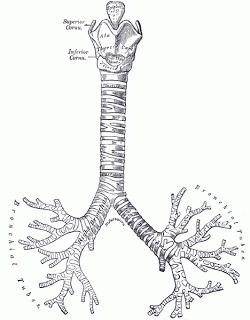A: I happen to be working on this post as I fly home from co-leading a yoga retreat in Mexico, which would have been all well and good except for the fact that I had a cold when I left over a week ago, and now I am still battling with a persistent, non-productive cough that feels like it is in my chest and not my throat. When I slip my doctor hat on, I can’t help but be suspicious that I may have gone from having a typical winter cold to possibly having an acute bronchitis. Bronchitis is an inflammation of the bronchial tree, that part of the lung architecture just down stream from your trachea, which is the biggest part of the tubes that allow air to move from the outside down into the deepest parts of the lungs, the alveoli, where our breathing gases get exchanged. Bronchitis, especially the acute kind, usually implies an infection of some sort, typically a virus or a bacteria, the latter for which antibiotics might be needed to eliminate.

Bronchial Tree
Since my cold showed up nine days ago, I have not felt much like doing a yoga practice! I had a low-grade fever for the first three days, and any mild physical activity left me feeling exhausted, so asana practice seemed like a potentially aggravating idea. Then, when the cough settled in to my chest, lying flat on my back led to more coughing, and deeper breathing also could trigger a coughing fit. So about the only thing I felt up for and that left me feeling a bit more rested afterwards was propping my chest and head up on a long body pillow, and doing yoga nidra practice with the sankalpa: My Immune system is robust! So my personal take-home message for acute bronchitis is that less is more, and that could be true for our reader if the “chronic bronchitis” has already set in for the winter.Chronic bronchitis is a form of bronchitis that has been around for at least three months in the past two consecutive years and has the other following characteristics: daily cough that produces clear, white, yellow or green mucus, fatigue, slight fever and chills, and chest discomfort. Chronic bronchitis implies a constant irritation or inflammation of the lining of the bronchial tubes, and is often due to a history of cigarette smoking. Other factors can also lead to the chronic form of bronchitis, including air pollution as well as dust or toxic gases in the environment or workplace.
In addition to encouraging smokers to stop and those exposed to environmental factors to make smart changes, western medicine often recommends medications other than antibiotics, which are reserved for situations in which fever or change in color of mucus indicate an acute infection on top of the chronic symptoms. Instead, medicines that improve the symptoms might be recommended, like inhalers that help to dilate or open up the airways to allow easier breathing. And, depending on the overall severity of the symptoms, a very modified yoga practice might be necessary until the chronic bronchitis symptoms resolve for the season.
However, when our reader is in his or her nine months of relative respiratory good health, a combination of yoga practices might help prevent the severity and length of these seasonal bouts. All of the basic balanced yoga practices we have discussed for other conditions that lower the stress response will simultaneously improve immune function, so a regular, daily home asana, pranayama and meditation practice is a must. In particular, asanas that target stretching the tight musculature around the chest and ribs, like Cat/Cow, deep side bends like Gate latch Pose, and backbends like Bridge and Bow that open up the front chest could improve aspects of the overall respiratory system. Basic forward bends and twists will also help to address the entire three-dimensional area of the rib cage and lungs.
Pranayama focus is also very important here. If there is any hint of asthma as part of the picture, please review my posts on that topic and visit Barbara Benagh’s website to read her insights on modified breath practices. I’d focus on two specific pranayama practices:
- Improve overall lung capacity by very gradually working to lengthen your inhalation and exhalation. For example, if you find it easy now to do a two second inhalation and a two-second exhalation for a series of six breaths, begin to work towards four-second inhale and four-second exhale (4:4 breath). And when that gets easy, to for 6:6, and so on. Always work in a gentle way and avoid getting short of breath or shaky. If you do get short of breath or shaky, take a break, go down to a lower time ratio and proceed more gradually.
- Increase muscular strength of the accessory muscles of breathing that are often called into action in breathing conditions like chronic bronchitis by practicing either Kapalabhati, Skull Brightening Breath, or Bastrika, the Bellows breath. By improving the strength and endurance of the accessory muscles of breathing such as the four layers of your superficial abdominal muscles (to mention only a few), you will be improving the stamina of your breathing musculature. I’ll describe these techniques in a future post. But in the meantime, you can find good descriptions in Richard Rosen’s second book on pranayama, Pranayama Beyond the Fundamentals. And take your time with these techniques by initially doing only 15-30 seconds at a time. Take many days to gradually add more time to your practice.
—Baxter

